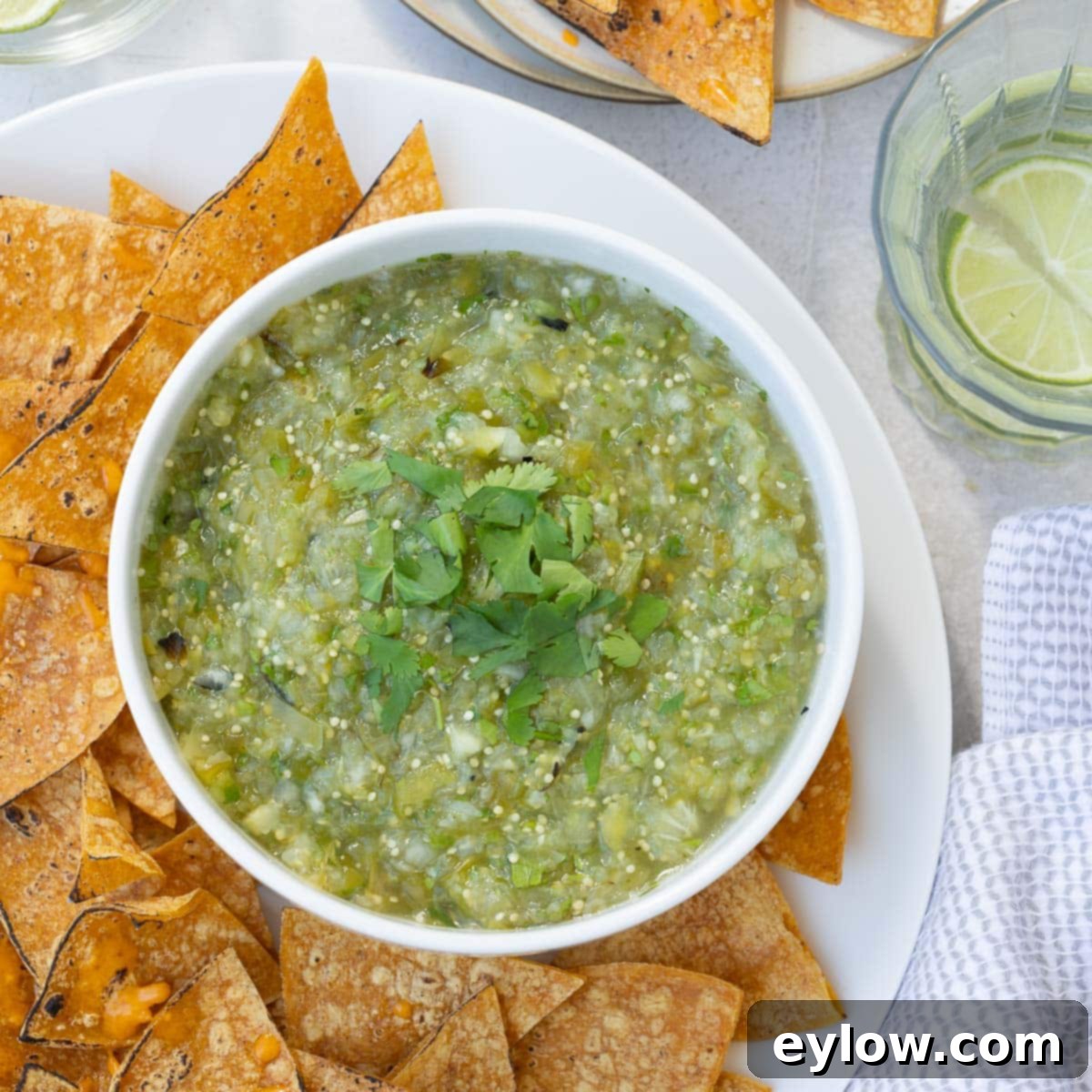Easy & Authentic Homemade Salsa Verde: Your Guide to the Freshest Tomatillo Sauce
There’s nothing quite like the vibrant, tangy kick of fresh **salsa verde** to awaken your taste buds. Forget the store-bought versions; once you experience the bright, herbaceous flavor of homemade tomatillo salsa, you’ll be hooked. This recipe delivers an addictively good, versatile green sauce that comes together in about 20 minutes, proving that superior flavor doesn’t have to be complicated. While it’s famously paired with crisp tortilla chips, this vibrant salsa has a myriad of uses beyond just dipping, making it a staple in any kitchen. Prepare to elevate your Mexican cuisine game and discover why making your own salsa verde is a culinary revelation.

For many, chips and salsa are an irresistible indulgence, a true weakness that brings joy with every scoop. But the experience is undeniably elevated when the salsa is made fresh, right in your own kitchen. Homemade salsa verde offers a significant advantage: no preservatives, no artificial additives, just pure, wholesome, and robust flavors from natural ingredients. If you’ve savored the authentic taste of salsa verde at your favorite Mexican restaurant, it’s time to recreate that magic at home. This recipe allows you to skip the often bland and overly processed store-bought varieties and enjoy a truly fresh and healthy condiment.
Why You’ll Love This Homemade Salsa Verde Recipe
This authentic salsa verde recipe isn’t just another condiment; it’s a game-changer for anyone who appreciates fresh, vibrant flavors and the joy of homemade cooking. Here are the compelling reasons why this particular recipe will become a cherished favorite:
- Unmatched Freshness and Flavor: The secret to exceptional salsa verde lies in its fresh ingredients. By using ripe tomatillos, aromatic cilantro, and zesty lime, you unlock a depth of tangy, bright, and truly authentic Mexican flavor that simply cannot be replicated by jarred alternatives. Each bite is bursting with the natural essence of garden-fresh produce.
- Customizable Heat Level: One of the greatest benefits of homemade salsa is the ability to tailor it to your personal preference. Whether you prefer a mild salsa with a gentle warmth or a fiery kick that leaves a pleasant burn, you have complete control over the heat. Adjust the amount of jalapeño peppers or choose a different chili to suit your palate, ensuring every batch is just right.
- Incredibly Versatile: While it’s a stellar companion for tortilla chips, this salsa verde is far more than just a dip. Its bright acidity and savory notes make it an incredibly versatile ingredient that can transform countless dishes. From breakfast to dinner, sweet to savory, you’ll find endless ways to incorporate this delicious green sauce into your meals.
- A Classic Taste of Mexican Cuisine: If you’re a lover of authentic Mexican food, mastering this easy salsa verde recipe is a must. Tomatillo salsa is a cornerstone of Mexican culinary tradition, offering a distinctive flavor profile that sets it apart from red salsas. It’s a fundamental element that brings the true essence of Mexico to your table.
For those who enjoy exploring diverse salsa flavors, consider trying a tropical pineapple mango salsa for a sweet and savory experience that transports your senses to an island getaway.
Essential Ingredients for Perfect Salsa Verde
Crafting the perfect homemade salsa verde begins with selecting the finest, freshest ingredients. Each component plays a vital role in creating the signature tangy, spicy, and herbaceous flavor profile that makes this green salsa so beloved. Below, we delve into the key ingredients and how to choose them for optimal results.
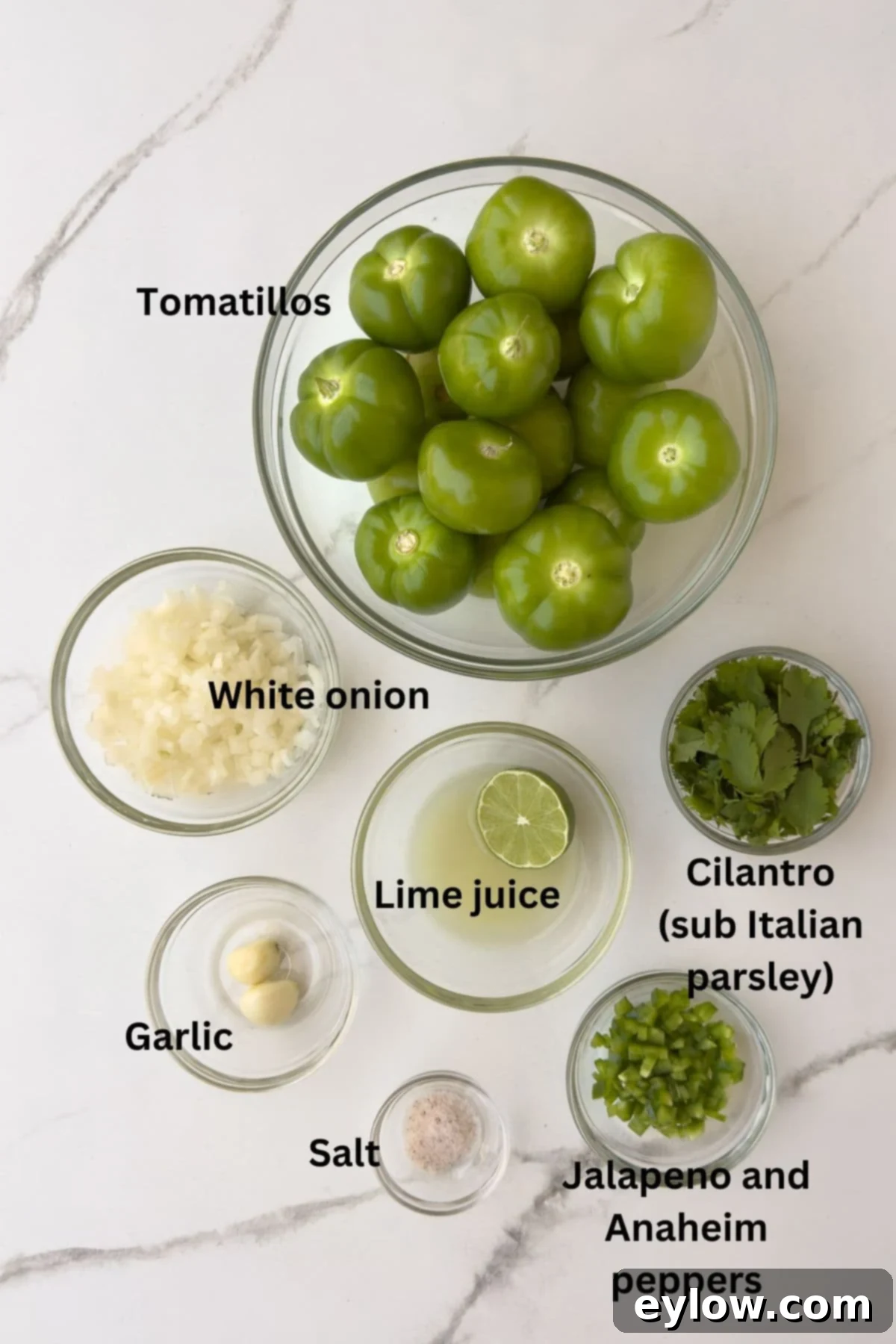
- Tomatillos: These small, green, paper-husked fruits are the star of salsa verde. While most commonly found green at grocery stores, they can also come in yellow and purple varieties. When selecting tomatillos, look for firm, bright green fruits with tight, papery husks that are not dried out or discolored. The stickiness you find after peeling the husk is normal and washes off easily. Their inherent tartness is what gives salsa verde its distinctive tangy base.
- Onion: White onion is the traditional choice for Mexican salsas due to its mild flavor and crisp texture, which complements the other ingredients without overpowering them. You can also use brown or yellow onions if white onions are unavailable, though they tend to have a slightly stronger, sweeter flavor. Choose firm onions with dry, papery skins.
- Jalapeño Peppers: These classic chili peppers provide the foundational heat for your salsa verde. Look for smooth, firm, and dark green jalapeños. While they vary in size, their heat level is somewhat unpredictable – some can be quite mild, while others pack a respectable punch. Typically, jalapeños offer a moderate heat that most people can enjoy. You can adjust the quantity based on your desired spice level.
- Anaheim Chile Pepper (Optional): While not strictly traditional for salsa verde, including half an Anaheim pepper adds wonderful volume, a beautiful bright green color, a subtle texture, and a pleasant, garden-fresh flavor. Anaheim peppers are generally mild, making them a great choice if you are sensitive to heat. If you can’t find them, don’t worry; your salsa will still be delicious without them.
- Cilantro: This fresh herb is non-negotiable for authentic Mexican recipes and especially for salsa verde. Its bright, citrusy, and slightly peppery notes are essential for the salsa’s characteristic aroma and taste. Choose fresh, vibrant green bunches without wilting or yellowing leaves. (See substitutions below if you’re not a fan of cilantro.)
- Garlic: Although not explicitly listed above, fresh garlic is a crucial aromatic that adds depth and pungency to the salsa. It’s often included in the broader “spices” or “aromatics” category but deserves special mention for its impact on flavor. Two cloves are typically sufficient, finely chopped or zested for maximum flavor distribution.
- Fresh Lime Juice: The juice from fresh limes provides a crucial burst of bright acidity that balances the richness of the other ingredients and enhances all the flavors. Always opt for fresh lime juice over bottled varieties for the best taste.
- Sea Salt: A simple yet powerful seasoning, sea salt brings all the flavors together and enhances the natural sweetness and tartness of the tomatillos. Adjust to taste to achieve perfect seasoning.
Please refer to the detailed recipe card below for precise measurements of each ingredient to ensure a perfectly balanced salsa verde.
Salsa Verde Substitutions and Flavor Variations
One of the beauties of homemade salsa verde is its adaptability. You can easily tweak ingredients to suit dietary needs, personal preferences, or simply to experiment with different flavor profiles. Here are some useful substitutions and variations to consider:
- If you don’t like cilantro, you’re not alone! Many people find cilantro to have a soapy taste due to a genetic predisposition. A great alternative is fresh flat-leaf parsley, which offers a similar herbaceous freshness without the divisive flavor. You can also use a mix of parsley and mint for an interesting twist.
- To incorporate healthy fats and add a layer of richness, stir in a couple of teaspoons of good quality olive oil. For an extra citrusy punch that complements the tomatillos, a lime-infused olive oil is a particularly terrific addition, enhancing the bright notes of the salsa.
- If your salsa verde turns out too tangy or acidic, sometimes even bordering on sour, a simple fix is to add a small pinch of sugar or granular monk fruit. This helps to balance the acidity and mellow the tartness without making the salsa overtly sweet. Start with a tiny amount and add more gradually until balanced.
- For a truly raw green salsa, reminiscent of a fresh pico de gallo but with tomatillos, you can skip the broiling step entirely. Simply peel and wash the tomatillos, roughly chop them, then combine with all other ingredients and puree in a food processor or blender. This yields a brighter, more pungent flavor and a crisp texture.
- If you crave a spicier salsa verde, there are a few ways to turn up the heat. Increase the quantity of jalapeños to two or even three, or opt for a hotter chili pepper such as serrano peppers, which are typically significantly spicier than jalapeños. Remember that most of the heat in chili peppers is concentrated in the white inner membranes, not just the seeds, so leaving some of the membrane in will also intensify the spice. Always wear gloves when handling hotter chilies to avoid skin irritation.
Looking for more appetizer and snack recipe ideas to serve alongside your delicious salsa? Explore our collection for inspiration.
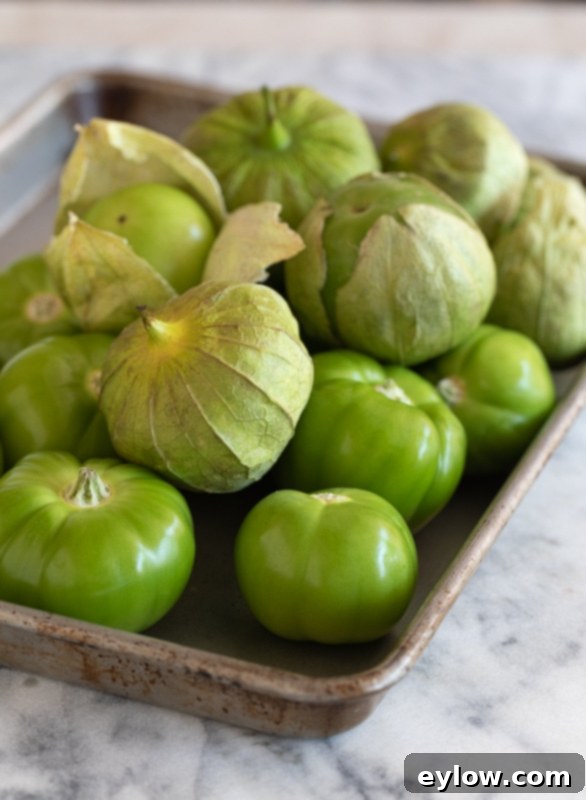
Step-by-Step Salsa Verde Instructions
Making homemade salsa verde is a straightforward process, but following these detailed steps will ensure you achieve the best possible flavor and texture. Get ready to transform fresh ingredients into a vibrant, tangy green sauce that will become your new favorite condiment.
Set-up for Success
Before you begin, proper preparation is key. Position an oven rack on the second level from the top, ensuring it’s about 4 inches below the broiler heating element. Preheat your broiler to get it nice and hot. Line a rimmed baking sheet (half sheet size works best) with aluminum foil; this simple step makes cleanup incredibly easy after broiling. Next, peel the papery husks off your tomatillos and give them a good wash under cool water to remove their natural sticky film. Finally, have your food processor or blender ready and within reach, as the process moves quickly once the tomatillos are roasted.
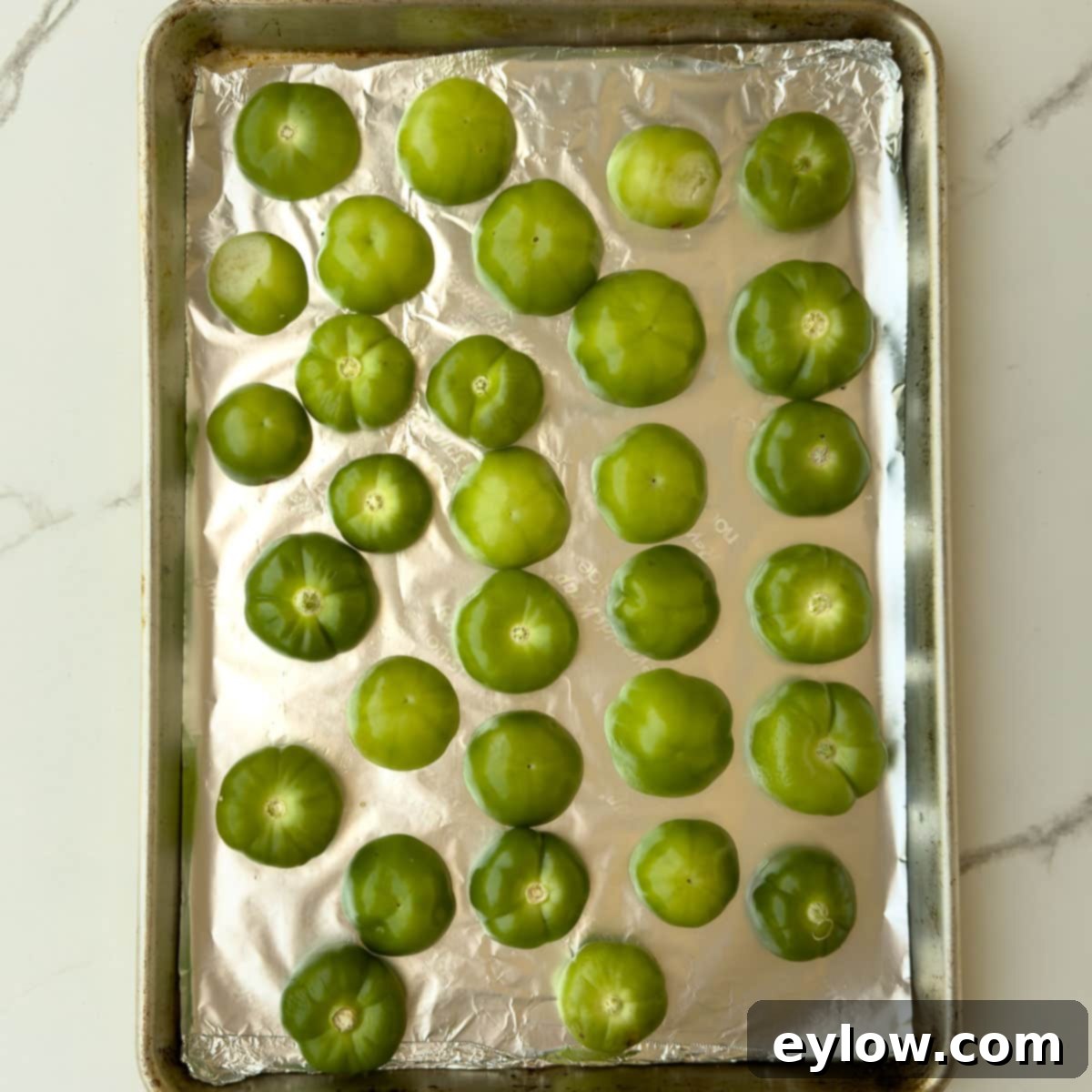

Preparation and Broiling
Step 1: Prepare Your Ingredients. Begin by cutting your clean tomatillos in half. Chop the white onion into rough pieces. For the peppers, first slice off the tops, then slice them lengthwise. Carefully remove the seeds and the inner white membrane – this is where most of the heat resides, so removing it will result in a milder salsa. Once destemmed and deseeded, cut the pepper pieces into long, thin strips, then chop them crosswise into smaller, manageable pieces. Finely chop or zest the garlic cloves (a microplane zester works wonderfully for a fine consistency), and roughly chop the fresh cilantro leaves. Having all your ingredients prepped ahead of time, known as mise en place, makes the blending process seamless.
Step 2: Broil the Tomatillos for Depth of Flavor. Arrange the halved tomatillos cut-side down on your foil-lined baking sheet. Place the baking sheet under the preheated broiler. Broil the tomatillos for approximately 5 minutes, or until you see attractive browned and lightly charred spots on their skins. This charring process adds a smoky depth and sweetness to the tomatillos, which is crucial for the salsa verde’s rich flavor profile. Once broiled, carefully remove the tray from the oven and allow the tomatillos to cool until they are safe and comfortable to handle. This cooling period is important before blending.
Chef’s Tip: Managing Chili Heat. It’s a common misconception that chili seeds are the source of most heat. In reality, the majority of the capsaicin (the compound responsible for heat) is found in the white inner membranes, or pith. To significantly reduce the heat level in hot chili peppers like jalapeños or serranos, meticulously slice out and remove these white membranes with a small paring knife. If you desire more heat, you can leave some or all of the membrane intact. For very hot peppers, consider wearing disposable kitchen gloves to protect your hands from the capsaicin.


Blending Your Salsa Verde
Step 3: Combine All Ingredients. Once the broiled tomatillos have cooled, transfer them to the bowl of your food processor. Add the chopped onions, minced garlic, fresh cilantro, prepared chilies (jalapeño and Anaheim if using), sea salt, and fresh lime juice. If you don’t have a food processor, a regular blender will also work effectively, though you might need to stop and scrape down the sides more frequently.
Step 4: Puree to Your Desired Texture. Secure the lid on your food processor or blender and begin to pulse the ingredients. Use short, controlled pulses to achieve your preferred salsa texture. You can pulse just a few times for a chunky, rustic salsa, or continue pulsing for a smoother, more refined sauce. Avoid over-processing to prevent a completely liquid consistency, unless that is your intention. Once the desired texture is reached, your homemade salsa verde is ready to serve! If you find the salsa is too juicy or thin for your liking, you can briefly strain it over a bowl through a fine-mesh sieve to achieve a thicker consistency.
Chef’s Tip: Dry Herbs for Cleaner Cuts. When working with fresh herbs, particularly soft, leafy varieties like cilantro and parsley, it’s best to wash them well in advance and ensure they are thoroughly dried before chopping. Dry herbs cut much more cleanly and evenly than wet ones, which tend to clump together and get bruised. A salad spinner or patting them dry with paper towels works wonders.
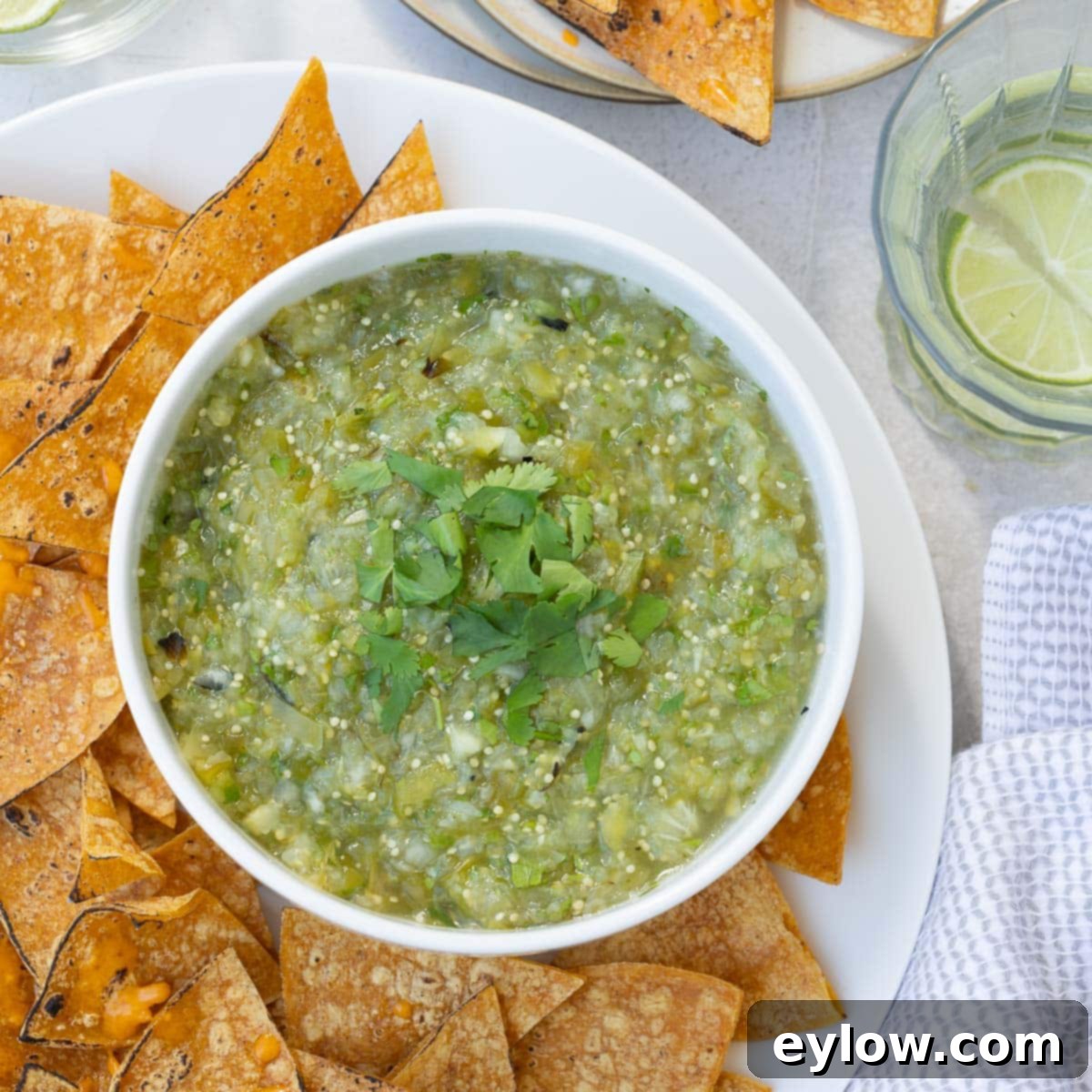
Serving Suggestions for Your Vibrant Salsa Verde
While the classic combination of crisp tortilla chips and salsa verde is always a winner, this versatile green sauce deserves to be explored in countless culinary applications. Its tangy, fresh, and slightly spicy profile makes it an incredible enhancer for a wide variety of dishes. Here are some inspired serving suggestions to help you make the most of your homemade salsa verde:
- Elevate Grilled Seafood: Drizzle a generous amount of salsa verde alongside or directly over grilled shrimp, scallops, or a fresh fish fillet (like cod, mahi-mahi, or snapper). The bright acidity and herbal notes cut through the richness of the seafood, creating a perfectly balanced bite.
- A Perfect Companion for Meats: This salsa is not just for seafood. It acts as an excellent finishing sauce for various grilled meats. Try it with grilled flank steak, chicken, or pork. Its fresh flavor provides a wonderful contrast to savory, smoky meats.
- Breakfast Brilliance: Transform your morning meal into a fiesta! Spoon salsa verde over scrambled, poached, or fried eggs. It’s also an exceptional alternative to traditional red sauce for Huevos Rancheros, offering a brighter, tangier twist to this classic Mexican breakfast.
- Taco & Burrito Booster: Take any taco or burrito to the next level. Whether it’s beef, chicken, fish, or vegetable tacos, a dollop of this verde sauce adds incredible flavor. Imagine breakfast tacos with fluffy scrambled eggs, topped with this zesty salsa – a truly satisfying start to your day.
- As a Marinade: Use it as a quick marinade for chicken or fish before grilling or baking to infuse it with vibrant Mexican flavors.
- With Roasted Vegetables: Toss roasted vegetables like zucchini, bell peppers, or corn with salsa verde for a refreshing side dish.
- In Soups and Stews: Stir a spoonful or two into a bowl of chicken tortilla soup or black bean soup for an extra layer of complexity.
For the best flavor experience, serve your salsa verde at room temperature. The subtle warmth allows the intricate aromas and tastes of the fresh ingredients to truly shine. Store any leftover salsa verde in an airtight container in the refrigerator, where it will maintain its freshness for 4-5 days (though it’s so good, it likely won’t last that long!). If you find yourself with an excess, don’t hesitate to freeze it. While freezing may alter the texture slightly, making it a bit softer upon thawing, the delicious flavor will remain intact. You can always give it another quick pulse in a food processor after thawing if you prefer a smoother consistency.
Dietary Notes & Considerations
Understanding the dietary implications of your ingredients is important for many home cooks. Here are a few notes regarding this salsa verde recipe:
- Nightshades: If you have a sensitivity or allergy to nightshades, this recipe may not be suitable for you, as tomatillos are indeed part of the nightshade family, just like tomatoes.
- Histamine Intolerance: For individuals managing histamine intolerance, this salsa verde should generally be a safe choice. Unlike traditional red salsas made with tomatoes, which are high in histamines, tomatillos are typically low in histamines. This makes green salsa a favorable alternative for those on a low-histamine diet.
Salsa Verde Recipe FAQs
Salsa verde is incredibly versatile and pairs well with much more than just tortilla chips. It’s fantastic spooned over grilled fish and seafood, such as shrimp or white fish, and makes a bright, tangy side sauce for various grilled meats like steak or chicken. For breakfast, try it with scrambled, poached, or fried eggs for a zesty start to your day. It’s also a delicious and vibrant alternative to red sauce for classic Mexican dishes like Huevos Rancheros, enchiladas, or chilaquiles, providing a fresh and zippy flavor.
Salsa can be prepared in both cooked and raw forms, and salsa verde is no exception. A raw salsa is often referred to as “salsa cruda,” similar to a fresh pico de gallo made with uncooked red tomatoes. In this particular salsa verde recipe, we achieve a wonderful depth of flavor by broiling the tomatillos, which softens them and adds a subtle smokiness and sweetness. However, if you prefer a raw version, you can certainly skip the broiling step. Just roughly chop the raw tomatillos and blend them directly with the other ingredients for a brighter, more pungent, and crisper salsa.
The primary difference between “salsa” (often referring to salsa roja, or red salsa) and salsa verde lies in their main ingredient and, consequently, their color and flavor profile. Traditional red salsa is predominantly made with red tomatoes, along with onions, garlic, lime juice, and cilantro. It typically offers a sweeter, sometimes smoky, and rich tomato flavor. Green salsa verde, on the other hand, uses green tomatillos as its base ingredient. It’s important to note that tomatillos are not simply unripe green tomatoes; they are a distinct fruit with their own unique tart, almost citrusy flavor profile, which gives salsa verde its signature tangy and bright character. Both salsas are delicious and integral to Mexican cuisine, but they offer distinct experiences.
More Mexican-Inspired Recipes to Explore
If you’ve fallen in love with the tangy goodness of tomatillos in this salsa verde, you’re in for a treat! Tomatillos are a fantastic ingredient for adding bright, zesty flavor to a variety of Mexican-inspired dishes. Here are a few more delicious tomatillo-based recipes to broaden your culinary horizons. And to complete your Mexican feast, why not pair them with a refreshing and authentic Mexican Caesar salad, made with the best creamy homemade Caesar dressing you’ll ever taste?
- Easy Salsa Verde Chicken (Green Salsa Chicken)
- Tomatillo Sauce (Green Enchilada Sauce)
- Mexican Chicken Tomatillo Soup
- Caesar Salad Dressing Without Anchovies
⭐️Did You Make This Recipe?
We absolutely love hearing from you! If you’ve tried your hand at this homemade salsa verde recipe, please take a moment to share your experience by adding a comment below. Your feedback is invaluable, and we truly enjoy connecting with our community. If you found this recipe to be as delightful as we do, we’d be incredibly grateful if you could give it a 5-star rating! Your ratings and reviews are a huge help to other readers looking for delicious recipes.
📖 Recipe

Salsa Verde (Tomatillo Salsa)
Sally Cameron
Pin Recipe
Equipment
-
Rimmed baking sheet (½ sheet size)
-
Food Processor or blender
-
Disposable kitchen gloves optional, for handling hot peppers
Ingredients
- 2 pounds green tomatillos (about 15 medium tomatillos)
- ½ cup chopped white onion (about ½ a medium onion)
- 1-2 jalapeño peppers (seeded and membranes removed for milder heat)
- ½ Anaheim pepper (optional, adds volume and mild flavor)
- ½ cup chopped fresh cilantro leaves (about ½ a bunch, well-packed)
- 2 cloves garlic (finely chopped or grated)
- 1 tablespoon fresh lime juice (from about 1 medium lime)
- ½ teaspoon sea salt (or more to taste)
Instructions
Set-up
-
Pre-heat your oven broiler and position the oven rack on the second level down from the top, roughly 4 inches below the heating element. Line a half sheet size rimmed baking sheet with aluminum foil for easy cleanup.
Broil Tomatillos & Prep Peppers
-
Peel the papery husks from the tomatillos and thoroughly wash off their sticky outer film under cool water. Cut each tomatillo in half and arrange them cut-side down on the prepared baking sheet. Place the tray under the preheated broiler and broil for approximately 5 minutes, or until the tops of the tomatillos show browned, lightly charred areas. This charring adds significant flavor. Once broiled, remove the tray from the oven and let the tomatillos cool down until they are comfortable to handle.
-
While tomatillos are cooling, prepare your peppers. Slice off the tops of the jalapeño (and Anaheim, if using) peppers. Slice them lengthwise, then carefully shake out the seeds and slice out the inner white membrane (this reduces the heat significantly). Cut the deseeded pieces into long, thin strips, then chop them crosswise into small pieces. Also, finely chop or grate your garlic cloves and roughly chop the fresh cilantro.
Make the Salsa Verde
-
Transfer the cooled broiled tomatillos to your food processor. Add the chopped onions, minced garlic, cilantro, prepared chilies, sea salt, and fresh lime juice. If you do not have a food processor, a blender can be used as an alternative, though you might need to blend in smaller batches and stop to scrape down the sides more often.
-
Secure the lid and pulse the mixture using short bursts. Continue pulsing until the salsa reaches your desired texture – from a chunky, rustic consistency to a smoother, more uniform sauce. Avoid over-processing if you prefer a salsa with some texture. For a thicker salsa, you can briefly drain it over a fine-mesh strainer set over a bowl. Your vibrant salsa verde is now ready to serve and enjoy!
Notes
For raw green salsa: If you prefer a brighter, uncooked salsa, simply skip the broiling step entirely. Peel and wash the raw tomatillos, then roughly chop them. Combine them with all the other fresh ingredients in your food processor or blender and pulse until you achieve your desired chunky or smooth texture.
To add healthy fat and enhanced flavor: Swirl in a tablespoon or two of a good quality extra virgin olive oil. For an extra layer of bright, citrusy taste, consider using a lime-infused olive oil – it’s a delicious addition!
